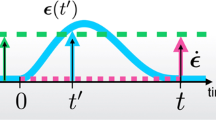Abstract
IT is well known that from an evaluation of the vibrational energy of a diatomic molecule, as a function of the vibrational quantum number n, it is possible to deduce quantitatively the law of force of the molecule, in the vicinity of the equilibrium position of the two nuclei. Now when the dipole rotates, the nuclear separation r increases, and the amount of this increase depends upon the forces called into play when the nuclei are displaced from the equilibrium distance ro. But these are the same forces which determine the frequency of vibration vo and the vibrational energy. Hence, if neither the vibration nor the rotation is sufficiently violent to distort the electron orbits appreciably, there should be a direct connexion between the constants which enter into the vibrational energy function, and those which characterise the rotational energy.
This is a preview of subscription content, access via your institution
Access options
Subscribe to this journal
Receive 51 print issues and online access
$199.00 per year
only $3.90 per issue
Buy this article
- Purchase on Springer Link
- Instant access to full article PDF
Prices may be subject to local taxes which are calculated during checkout
Similar content being viewed by others
Author information
Authors and Affiliations
Rights and permissions
About this article
Cite this article
BIRGE, R. The Law of Force and the Size of Diatomic Molecules, as Determined by their Band Spectra. Nature 116, 783–784 (1925). https://doi.org/10.1038/116783a0
Issue Date:
DOI: https://doi.org/10.1038/116783a0
Comments
By submitting a comment you agree to abide by our Terms and Community Guidelines. If you find something abusive or that does not comply with our terms or guidelines please flag it as inappropriate.



